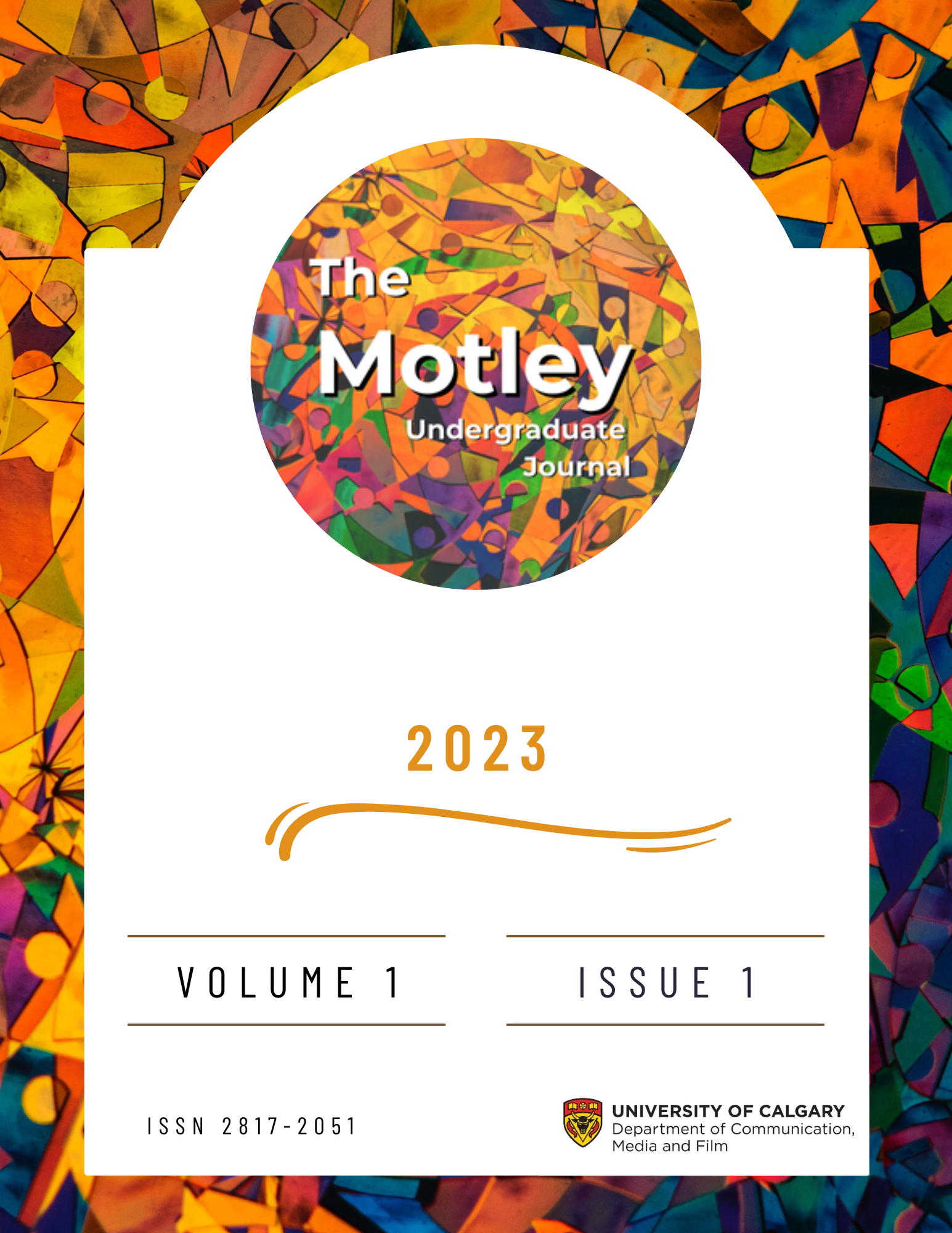Performing Muslim identities through embodiment
Self-representing through fashion, aesthetics, and style
DOI:
https://doi.org/10.55016/ojs/muj.v1i1.76088Keywords:
identity politics, hijabi influencers, visual rhetoric, fashion, female identitiesAbstract
Modesty is practiced by people regardless of their class, sexuality, gender, race, or religion. However, there is an association between modesty, Islam, and the Islamic veil (or hijab). Hijab is an Islamic garment that is meant for Muslim women to wear if they choose to do so. Vast interpretations of Islamic texts produce variability in the definitions and understandings surrounding modesty. Veiled Muslim women practice modesty by concealing their hair, skin, and body. The veil is a signifier of their religious affiliation and modest lifestyle. This paper is a study of performance and visual enactment within the photos and videos posted by a sample of veiled Muslim women influencers, which include Nawal Sari and Rawdah Mohamed. Hijabi influencers, or hijabistas, are veiled Muslim women who are consistent with fashion trends and hijab styles in an online context. This article uses visual rhetorical analysis to examine the captions and the clothing, pose, background, symbols, colours and textures present in the photos and videos. By doing this, this paper seeks to examine how hijabi influencers define Islamic modesty through the photos and videos uploaded on their visual social media platforms. Theoretical frameworks, such as post-colonial feminism, orientalism, and creative labour support the interpretation of the data. This research demonstrates that the definition of Islamic modesty can be understood beyond a binary perspective.
Downloads
References
Ahmed, S. (2000). Strange Encounters: Embodied Others in Post-Coloniality. London: Routledge.
Al-Saji, A. (2010). The racialization of Muslim veils: A philosophical analysis. Philosophy & Social Criticism, 36(8), 875–902. https://doi.org/10.1177/0191453710375589
Benjamin, W. (1923). The task of the translator. In Walter Benjamin: Selected Writings (1), ed. Marcus Bullock and Michael W. Jennings, Harvard University Press.
Byng, M. D. (2010). Symbolically Muslim: Media, Hijab, and the west. Critical Sociology, 36(1), 109–129. https://doi.org/10.1177/0896920509347143
Foss, K. A., & Foss, S. K. (2020). An explication of visual enactment in Advanced Style:
Fashioning a challenge to the ideology of old age. Western Journal of Communication, 84(2), 123-147. https://doi-org.ezproxy.lib.ucalgary.ca/10.1080/10570314.2019.1658892
Droogsma, A, R. (2007) Redefining Hijab: American Muslim Women's Standpoints on Veiling, Journal of Applied Communication Research, 35(3), 294-319. DOI: 10.1080/00909880701434299
Fayyaza, W., & Kamal, A. (2014). Practicing Hijab (veil): A source of autonomy and self-esteem for modern Muslim women. The Journal of Humanities and Social Sciences., 22(1). Knowledge Bylanes.
Foss, S. K. (2005) Theory of Visual Rhetoric. Handbook of Visual Communication: Theory, methods and media. pp. 141-152.
Gill, R., & Pratt, A. (2008). In the Social Factory?: Immaterial Labour, Precariousness and Cultural Work. Theory, Culture & Society. 25(7-8), pp. 1-30. DOI: 10.1177/0263276408097794
Gries, L. (2020). Advances in visual rhetorical analysis. In L. Pauwels & D. Mannay (Eds.), The SAGE handbook of visual research methods (pp. 381-396). SAGE Publications. doi: https://dx.doi.org/10.4135/9781526417015.
Hassan, S. H., & Harun, H. (2016). Factors influencing fashion consciousness in hijab fashion consumption among hijabistas. Journal of Islamic Marketing, 7(4), 476–494. https://doi.org/10.1108/jima-10-2014-0064
Hoodfar, H. (1993). The veil in their minds and on our heads: the persistence of colonial images of Muslim women. Resources for Feminist Research, 22(3), 5-18. https://ezproxy.lib.ucalgary.ca/login?url=https://www.proquest.com/scholarly-journals/veil-their-minds-on-our-heads-persistence/docview/194879317/se-2?accountid=9838
Lodi, H. (2020). Modesty: A Fashion Paradox: Uncovering the causes, controversies and key players behind the global trend to conceal rather than reveal. Neem Tree Press.
Mohamed, R. (rawdis). (2022, January 30). “On some red tings” (Photo). Instagram. https://www.instagram.com/p/CZXDVTdMrSo/?utm_medium=copy_link
Mohamed, R. (rawdis). (2022, March 2) “Magnificent jacket by @abdel.el.tayeb” (Video). Instagram. https://www.instagram.com/reel/CanD1GvjbOR/?utm_medium=copy_link
Mohanty, T. C. (1984). Under Western Eyes: Feminist scholarship and colonial discourses. Boundary 2. Spring – Autumn, (12/13)., (12)3., (13)1., pp. 333-358. On Humanism and the University, I: The Discourse of Humanism. Duke Univeristy Press
Najmabadi, A. (2005). Women’s Veil and Unveil. In Women with Mustaches and Men without Beards: Gender and Sexual Anxieties of Iranian Modernity (pp. 132-155). Berkeley: University of California Press. https://doi.org/10.1525/9780520931381-008
Said, W. E. (1978). Orientalism. New York: Pantheon Books.
Sari, N. (nawalsari). (2021, December 2). “I’ve always admired @hntaj’s work for diversity and inclusion…” (Photo). Instagram. https://www.instagram.com/p/CW-ZEP-vJtJ/?utm_medium=copy_link
Sari, N. (nawalsari). (2021, August 13). (Video). TikTok. https://vm.tiktok.com/ZMLYVfXoR/
Satiti, U. L. N. (2017). Representation of Muslim Women in the Western Media. Journal Ilmu Komuniskasi, 14(2), 189-202.
Shirazi, F. (2020). Hijab, Islamic Fashion and Modest Clothing: Hybrids of modernity and religious commodity. In Howe (Eds.), The Routledge Handbook of Islam and Gender (1st Ed.). (pp. 407-422). Routledge. https://doi-org.ezproxy.lib.ucalgary.ca/10.4324/9781351256568
Ternikar, F. (2009). Hijab and the Abrahamic Traditions: A comparative analysis of the Muslim veil. Sociology Compass., 3(5), p. 754-763. DOI: 10.1111/j.1751-9020.2009.00237.x
The noble quran. Quran.com. (n.d.). Retrieved November 16, 2021, from https://quran.com/.
Zine, J. (2002). Muslim women and the politics of representation. American Journal of Islam and Society, 19(4), 1–22. https://doi.org/10.35632/ajis.v19i4.1913
Downloads
Published
How to Cite
Issue
Section
License
Copyright (c) 2023 Asma Bernier

This work is licensed under a Creative Commons Attribution-ShareAlike 4.0 International License.
Copyright Policy
The Motley Undergraduate Journal is an Open Access article distributed under the terms of the Creative Commons Attribution 4.0 Share-Alike License. Under this license, users are free to share (copy, distribute and transmit) and remix (adapt) the contribution, including for commercial purposes, providing that the original work is properly cited. Under Creative Commons, authors retain copyright in their articles.
Author Self Archiving Policy
Authors are permitted to post their work online in institutional/disciplinary repositories or on their own websites. Pre-print versions posted online should include a citation and link to the final published version in The Motley Undergraduate Journal as soon as the issue is available; post-print versions (including the final publisher's PDF) should include a citation and link to the journal's website.

